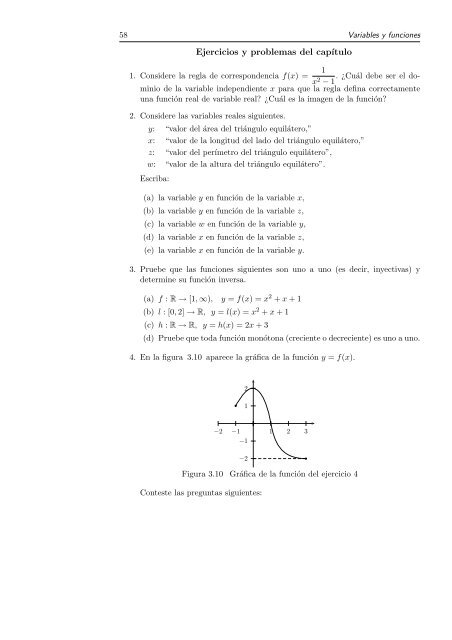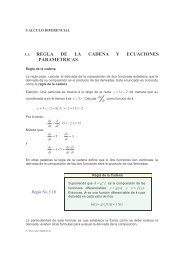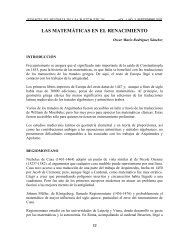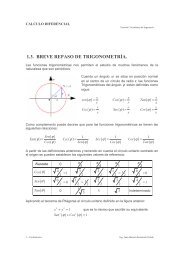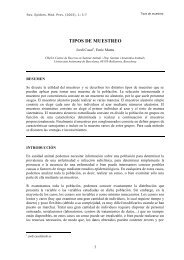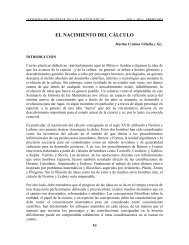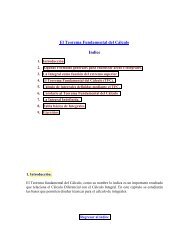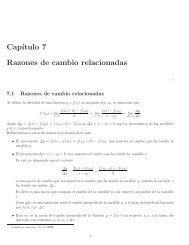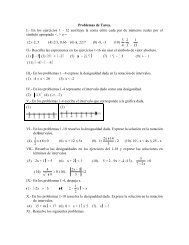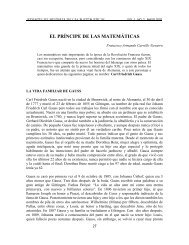- Page 1:
Fundamentos del Cálculo Rubén Flo
- Page 4 and 5:
4 Contenido 4.3 Sucesiones monóton
- Page 6 and 7:
6 Contenido 12.3 Series positivas .
- Page 8 and 9: 8 Presentación niveles de formaci
- Page 10 and 11: 10 Presentación con los resultados
- Page 12 and 13: 12 Presentación
- Page 14 and 15: 14 Una historia breve del cálculo
- Page 16 and 17: 16 Una historia breve del cálculo
- Page 18 and 19: 18 Una historia breve del cálculo
- Page 20 and 21: 20 Una historia breve del cálculo
- Page 22 and 23: 22 Los números reales decimal. Por
- Page 24 and 25: 24 Los números reales representa l
- Page 26 and 27: 26 Los números reales Ejemplo 2.5
- Page 28 and 29: 28 Los números reales A partir de
- Page 30 and 31: 30 Los números reales manera densa
- Page 32 and 33: 32 Los números reales Ejemplo 2.9
- Page 34 and 35: 34 Los números reales Propiedad de
- Page 36 and 37: 36 Los números reales constituye u
- Page 38 and 39: 38 Los números reales Ejercicios y
- Page 40 and 41: 40 Los números reales
- Page 42 and 43: 42 Variables y funciones A las vari
- Page 44 and 45: 44 Variables y funciones Al escribi
- Page 46 and 47: 46 Variables y funciones variable y
- Page 48 and 49: 48 Variables y funciones 3.1.1 Grá
- Page 50 and 51: 50 Variables y funciones Ejemplo 3.
- Page 52 and 53: 52 Variables y funciones La operaci
- Page 54 and 55: 54 Variables y funciones Px Px x 1
- Page 56 and 57: 56 Variables y funciones 3. La func
- Page 60 and 61: 60 Variables y funciones (a) Diga p
- Page 62 and 63: 62 Fundamentos del Cálculo Ejemplo
- Page 64 and 65: 64 Fundamentos del Cálculo Las ope
- Page 66 and 67: 66 Fundamentos del Cálculo anterio
- Page 68 and 69: 68 Fundamentos del Cálculo Proposi
- Page 70 and 71: 70 Fundamentos del Cálculo y en el
- Page 72 and 73: 72 Fundamentos del Cálculo La prop
- Page 74 and 75: 74 Fundamentos del Cálculo Por otr
- Page 76 and 77: 76 Fundamentos del Cálculo para n
- Page 78 and 79: 78 Fundamentos del Cálculo y Por t
- Page 80 and 81: 80 Fundamentos del Cálculo Definic
- Page 82 and 83: 82 Fundamentos del Cálculo puntos
- Page 84 and 85: 84 Fundamentos del Cálculo y f(x2)
- Page 86 and 87: 86 Fundamentos del Cálculo Ejercic
- Page 88 and 89: 88 Fundamentos del Cálculo
- Page 90 and 91: 90 Medida de la razón de cambio: l
- Page 92 and 93: 92 Medida de la razón de cambio: l
- Page 94 and 95: 94 Medida de la razón de cambio: l
- Page 96 and 97: 96 Medida de la razón de cambio: l
- Page 98 and 99: 98 Medida de la razón de cambio: l
- Page 100 and 101: 100 Medida de la razón de cambio:
- Page 102 and 103: 102 Medida de la razón de cambio:
- Page 104 and 105: 104 Medida de la razón de cambio:
- Page 106 and 107: 106 Medida de la razón de cambio:
- Page 108 and 109:
108 Medida de la razón de cambio:
- Page 110 and 111:
110 Medida de la razón de cambio:
- Page 112 and 113:
112 Medida de la razón de cambio:
- Page 114 and 115:
114 Teorema del valor medio y sus a
- Page 116 and 117:
116 Teorema del valor medio y sus a
- Page 118 and 119:
118 Teorema del valor medio y sus a
- Page 120 and 121:
120 Teorema del valor medio y sus a
- Page 122 and 123:
122 Teorema del valor medio y sus a
- Page 124 and 125:
124 Teorema del valor medio y sus a
- Page 126 and 127:
126 Teorema del valor medio y sus a
- Page 128 and 129:
128 Teorema del valor medio y sus a
- Page 130 and 131:
130 Teorema del valor medio y sus a
- Page 132 and 133:
132 Teorema del valor medio y sus a
- Page 134 and 135:
134 Teorema del valor medio y sus a
- Page 136 and 137:
136 Teorema del valor medio y sus a
- Page 138 and 139:
138 Teorema del valor medio y sus a
- Page 140 and 141:
140 Teorema del valor medio y sus a
- Page 142 and 143:
142 Teorema del valor medio y sus a
- Page 144 and 145:
144 Teorema del valor medio y sus a
- Page 146 and 147:
146 La función exponencial y sus a
- Page 148 and 149:
148 La función exponencial y sus a
- Page 150 and 151:
150 La función exponencial y sus a
- Page 152 and 153:
152 La función exponencial y sus a
- Page 154 and 155:
154 La función exponencial y sus a
- Page 156 and 157:
156 La función exponencial y sus a
- Page 158 and 159:
158 La función exponencial y sus a
- Page 160 and 161:
160 La integral indefinida rencial
- Page 162 and 163:
162 La integral indefinida Funció
- Page 164 and 165:
164 La integral indefinida Ejemplo
- Page 166 and 167:
166 La integral indefinida donde se
- Page 168 and 169:
168 La integral indefinida donde c
- Page 170 and 171:
170 La integral indefinida y aplica
- Page 172 and 173:
172 La integral indefinida 8.2.4 In
- Page 174 and 175:
174 La integral indefinida las cual
- Page 176 and 177:
176 La integral indefinida (a) (b)
- Page 178 and 179:
178 La integral indefinida
- Page 180 and 181:
180 La integral definida Cada parti
- Page 182 and 183:
182 La integral definida Nótese qu
- Page 184 and 185:
184 La integral definida inferior d
- Page 186 and 187:
186 La integral definida Luego, hem
- Page 188 and 189:
188 La integral definida Al tomar l
- Page 190 and 191:
190 La integral definida Proposici
- Page 192 and 193:
192 La integral definida 2. El teor
- Page 194 and 195:
194 La integral definida Análogame
- Page 196 and 197:
196 La integral definida Ejemplo 9.
- Page 198 and 199:
198 La integral definida (a) Utiliz
- Page 200 and 201:
200 La integral definida
- Page 202 and 203:
202 Aplicaciones de la integral def
- Page 204 and 205:
204 Aplicaciones de la integral def
- Page 206 and 207:
206 Aplicaciones de la integral def
- Page 208 and 209:
208 Aplicaciones de la integral def
- Page 210 and 211:
210 Aplicaciones de la integral def
- Page 212 and 213:
212 Aplicaciones de la integral def
- Page 214 and 215:
214 Aplicaciones de la integral def
- Page 216 and 217:
216 Aplicaciones de la integral def
- Page 218 and 219:
218 Aplicaciones de la integral def
- Page 220 and 221:
220 Ecuaciones diferenciales elemen
- Page 222 and 223:
222 Ecuaciones diferenciales elemen
- Page 224 and 225:
224 Ecuaciones diferenciales elemen
- Page 226 and 227:
226 Ecuaciones diferenciales elemen
- Page 228 and 229:
228 Ecuaciones diferenciales elemen
- Page 230 and 231:
230 Ecuaciones diferenciales elemen
- Page 232 and 233:
232 Ecuaciones diferenciales elemen
- Page 234 and 235:
234 Ecuaciones diferenciales elemen
- Page 236 and 237:
236 Ecuaciones diferenciales elemen
- Page 238 and 239:
238 Ecuaciones diferenciales elemen
- Page 240 and 241:
240 Series Ejemplo 12.1 ∞ 1 1. L
- Page 242 and 243:
242 Series ∞ 1 a la serie armóni
- Page 244 and 245:
244 Series Demostración. Para most
- Page 246 and 247:
246 Series Criterio de Cauchy. Si l
- Page 248 and 249:
248 Series Note que los términos N
- Page 250 and 251:
250 Series 1. Si una serie ∞ i=1
- Page 252 and 253:
252 Series Corolario 12.6 (Criterio
- Page 254 and 255:
254 Series Ejemplo 12.11 La serie d
- Page 256 and 257:
256 Series donde zn,h ∈ (x0, xn,h
- Page 258 and 259:
258 Series Aplicando repetidamente
- Page 260 and 261:
260 Series 5. Diga en qué interval
- Page 262 and 263:
Índice Abel, Niels Henrik 252 Absc
- Page 264 and 265:
264 Índice real de variable real 4
- Page 266:
266 Índice inducida por la sucesi


